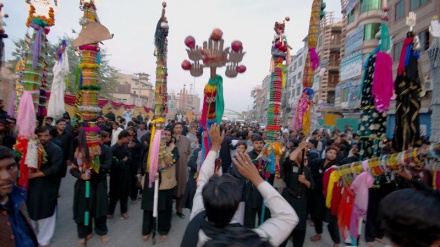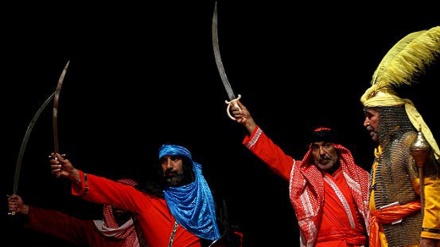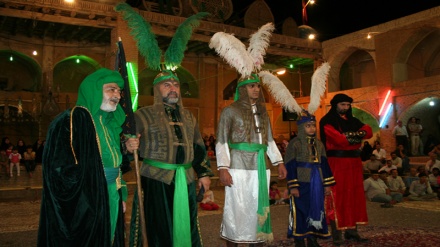Muharram mourning traditions in different lands - 31
Welcome to the 31st part of the 40-plus episodes of a new and interesting series titled “Muharram Mourning Traditions in Different Lands” that we started broadcasting as of October 15 on a daily basis, to commemorate the heartrending tragedy of Karbala, and the martyrdom of Imam Husain (AS), the grandson of Prophet Mohammad (SAWA).
In this series, which delves into the various mourning traditions associated with the Immortal Epic of Ashura in various lands, we look at the history of mourning for Imam Husain (AS). Today we talk about the tradition of “taking round the flag” or “rotating the flag” – a tradition which is closely associated with the martyrdom of the Chief of Martyrs, Imam Husain (AS).
In Persian this tradition is known as “Alam Gardani”, and is one of the most important and the most common forms of mourning for the martyrs of Karbala. In some parts of Iran this is referred to as “Touq Gardani”, which means the same thing. The Arabic and Persian word “Alam” is translated variously as “flag”, “standard”, “banner” or “ensign”. Thus “Alam Gardani” literally means to “take round the flag” or “to rotate the flag”. The tradition of “taking round the flag” or “Alam Gardani” is performed in many different ways in different regions of Iran. During Muharram the flag or standard is wrapped in black, green and white cloth. A special ceremony, known as dressing of the flag – “Alam Bandan” in Persian –signals the beginning of mourning in Muharram, and another special ceremony, known as martyrdom of the flag or undressing of the flag – “Alam va Chini” in Persian – signals the end of mourning .
In the city of Birjand in South Khorasan Province in eastern Iran, the flag or standard is a very important part of mourning ceremonies for the martyrs of Karbala during Muharram. The people of Birjand revere the flag or standard. The ceremony known as dressing up of the flag – “Alam Bandan” in Persian – usually takes place on the first, second, third, fourth, and seventh of the month of Muharram, in the city of Birjand and surrounding villages. Sometimes this ceremony is performed in a mosque, but more often, it takes place in the home of the person who is “the keeper or guardian of the flag”.
All flags and standards have keepers (or guardians) and this tradition is passed from father to son -- usually the eldest son in the family. So it is true to say that the keepers of the Muharram flag in Birjand and surrounding areas have inherited this duty or title from their fathers.
During the “Alam Bandan” ceremony, Muharram elegies and lamentations are song by a person known as “Chavoshi Khan” as the flag or standard is being decorated for mourning. In the village of Derakhsh, near Birjand, the “Alam Bandan” ceremony is usually performed on the fourth of Moharram. A total of fourteen standards or flags are “dressed up” in a special ceremony at the Jame’ Mosque in the village of Derakhsh. These standards are then used in processions and mourning ceremonies right up until the afternoon of Ashura (10th of Muharram).
It should be noted that 12 of the standards or flags are named after the 12 Imams or Infallible Successors of Prophet Mohammad (SAWA), with one flag or standard being named after Hazrat Fatemah Zahra (SA), the Prophet’s Immaculate Daughter and mother of Imam Husain (AS). Another after Hazrat Abu’l-Fazl al-Abbas (AS), the brother of Imam Hussein (AS) and the courageous standard-bearer of Karbala.
In the city of Gorgan in north eastern Iran a similar traditional ceremony, known as “Touq Bandan”, is performed during the first ten days of Muharram. Traditionally each district of Gorgan performed this ceremony in a particular day of Muharram. The “Touq” joins on top of a five-meter-long flag or standard, and there are metallic and bronze pieces at the top, with Ayahs of the Holy Quran chiseled or etched on these pieces. The “Touq Bandan” mourning ceremonies reach their zenith on the ninth and tenth of Muharram, that is the days of Tasua and Ashura. Similar ceremonies are performed during Muharram in many other Iranian cities and towns, including the town of Tafresh in central Iran.
MD/AS/ME


